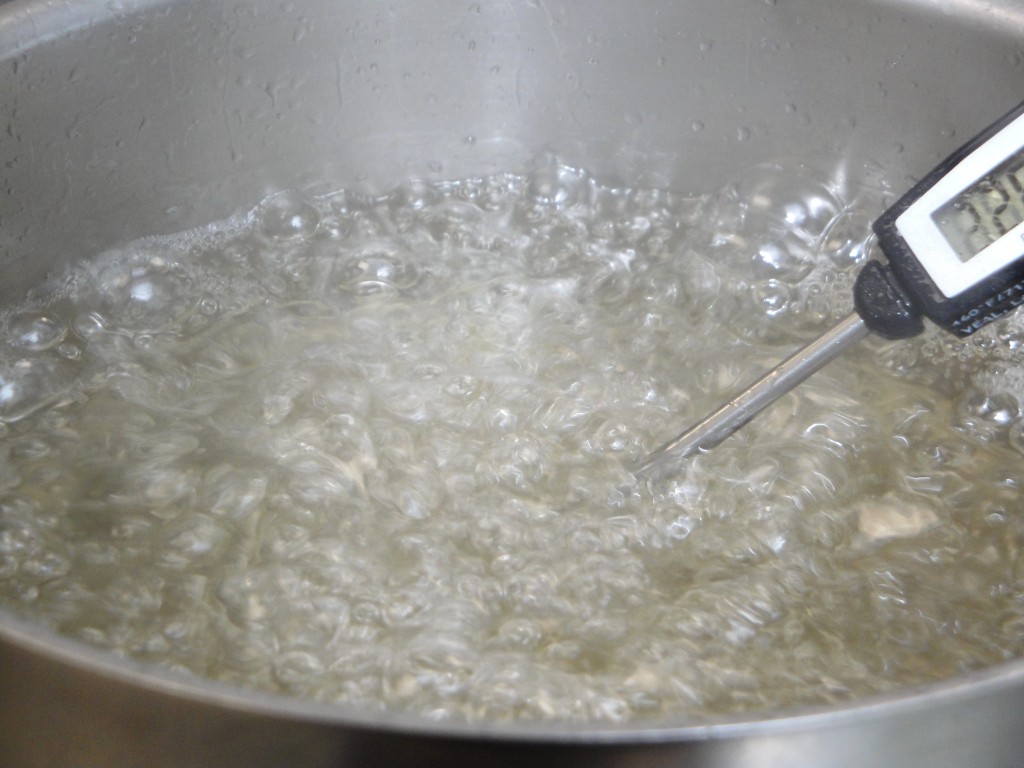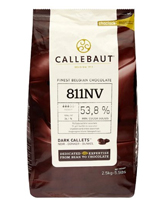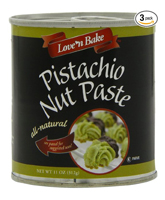Invert sugar- Invert Syrup- Trimoline
An advantage a professional pastry chef has is that certain key ingredients are readily available. One of these ingredients is invert sugar. Although invert sugar is close in chemical composition to honey, it is not found on most grocery store shelves. The good news is that homemade invert sugar is quickly made by anyone. For countless confectionary or baking applications, a corn syrup substitute or replacement can be invert sugar.
Invert sugar is used extensively in confectionary for preparations such as ganache, jellies, fudge, and taffy and in the preparation of sorbets and ice cream. Its ability for controlling crystallization and creating a smoother mouth feel in these products is the main reason why it is used in the first place. Invert sugar is hygroscopic which leads to a reduction of available water in food preparations, resulting in a longer shelf life of countless products. It lowers the spread of bacteria and basically acts as a preservative. The humectant properties of invert sugar are high and will keep products such as fillings for chocolates and fudge much longer moist and tender. Invert sugar also contributes to the Maillard reaction (caramelizing) and consequently will aid the browning process.
Also utilized in certain baked goods like Madeleine’s and brioche where invert sugar is used to increase tenderness and moistness. For all the above mentioned attributes of invert sugar the one I am most excited about is that invert sugar intensifies aromas, especially in sorbet and certain chocolate ganache applications. With so many desirable attributes in confectionary and baking, the question why use invert sugar, is no longer a mystery.

For many years confectioners and pastry chefs have added glucose and or corn syrup into boiled sugar applications to prevent these syrups from crystallizing. In these syrups, substituting corn syrup with invert sugar is something I have done for some time with parallel results.
In confectionary applications such as ganache, invert sugar can be the sole source of sweetener, but in the case of sorbet, gelato, ice cream or cakes only about 5-10% percent of sugar is replaced with invert sugar.
Getting it all together!
Invert sugar has a long shelf life so make a batch and keep it in your refrigerator in a well sealed container for at least 6 months. This way whenever you need to make a pound cake extra moist or control crystallization in gelato or make truffles extra creamy you are set to go!
Invert sugar
Yield: 2 lb 3 oz (1 kilo)
| 4 Cups + 6 Tablespoon | (2 lb 3 oz) | Extra fine granulated sugar | 1 kg |
| 2 cups | (16 fl oz) | Water | 480 ml |
| ¼ Teaspoon | ( ¼ tsp) | Cream of tartar or citric acid | 1 g |
- If you have an induction cook top or an electric stove use these options instead of gas. In a non reactive saucepan stir to a boil the sugar, water and cream of tartar (Or citric acid).
- Once the mixture boils wash away any sugar crystals stuck to the side of the pan with pastry brush dipped in water. Any additional water added to the pan from this process, has no effect on the final outcome.
- On medium heat without stirring boil the mixture to 236°F (114°C). Remove from heat and cover the pan. Let cool at room temperature. Store in a refrigerator. Invert sugar will last at least 6 moths.







Eddy
Please what is a “bombe Batter ” I’ve looked for it all over the internet and all I get are bomb squads please were not all chef ‘s
Hi.
A bombe batter is a mixture of egg yolks, sugar and sometimes a little liquid which can be made several ways. One, over a double boiler as is shown in the mascarpone cream and also can be made using a boiled syrup being poured onto whipping egg yolks. The latter version I will use pretty soon.
Thank you for your question.
Eddy.
Eddy
Hi first of all I would like to thank you for how quickly you responded to my question I really appreciate it very much . I would also like to apoligize for being rude about how I asked my question theres no excuse for it .
Thank You Again Sincerily Antero Suarez
Hi Antero,
No problem at all.
Pretty soon I will incorporate some chocolate decor as well in my articles.
All the best, Eddy.
Invert sugar is better than both glucose and corn syrup… Good advise from you chef eddy…
Thank you Chef Eddy for your informative article about the invert sugar,For sure I will start using it in my future recipes to get long lasting,moist,and most important ;healthy products , I also was wondering if we would be able to use it as substance in the recipes that call for dark corn syrup !! Thanks again for all your hard work.
Hi Doua,
Certainly you can replace dark corn syrup with invert sugar. One thing you can do to mimick the flavor and color is to add a small amount of molasses.
All the best, Eddy.
I’m so excited about the invert sugar! I made it this morning, so I’m going to try your marshmallows tonight with some different fruit juices. I’m also going to try it in the Traditional French Buttercream. It should work the same way in that recipe too, right? Thanks for the recipe!!!
Hi Sarah,
Yes, replacing corn syrup with invert sugar in butter cream should be no problem at all. We do it all the time with excellent results.
All the best Sarah!
Eddy
Chef Eddy,
Great post. I just recently discovered your website. I also have your On Baking book which I have used as a reference book for my baking and pastry classes in culinary school.
This maybe a silly question but I just want to confirm this. This invert sugar is trimoline, right? I’m a baking and pastry student and we have a lot of formulas calling for trimoline which is not available in stores (I’ve only found them online and they are quite expensive). Your title suggests it but I just want to confirm because my understanding is that trimoline and invert sugar are one and the same.
I know that this will require testing and it will vary by product, but do you also have a rule of thumb regarding sugar substitution for cakes (like genoise, for example)?
I will definitely try this at home and use it for various applications! Thank you so much!
Jess
Jess, Yes Trmoline and invert sugqr is the same thing. For Genoise-replace five to ten percent of sugqr with invert sugar. Thanks for your question. Sorry took me a while to respond, I am on holiday….. Eddy.
I just made invert sugar and it came out perfectly!
Hi,
First of thank you for this nice recipe and the help you give out.
I’ve tried it and at first everything looks nice, when it cools down the texture looks like transparent (no color at all) honey. I left it cool down at ambient temperature for about 2 hours or so. Once cooled down, I could poor the content into a sealed container (the bottom was really sticky but we can call it liquid). After I’ve put it in the fridge (about 2 hours later), a white cloudy white color started to appear in the middle of the container. The side was still liquid and transparent. I used a spoon to check the texture of the white part and it became a sort of cookie texture (granulated). I left it outside of the fridge and some hours later everything became white with the cookie texture and became one single block.
This is a picture of the final result:
http://www.pictures-upload.com/image-4394-6712.html
So there’s something I’ve done wrong, fortunately I did the recipe with 1/4th of the ingredients.
I used tartare cream with rafined castor sugar on a induction table at 120°C.
My guess is the problem resides in the cooking time (perhaps I cooked to long? But when do i know its ready?) or the storage (my container was more horizontal meaning air contact surface was greater?).
I hope you can help me out with this one.
Regards
David
It may have been cooked just a bit too much but do not worry about it being crystallized looking. Sometimes when students make this in class, the same thing happens. When you will use it, more then likely it will be boiled in a liquid anyway and it still will do what you are needing it for-to keep things longer moist or prevent them from crystallizing. I have done test with invert sugar which has a crystal look to it and one which does not. In Ganache-sorbet etc, the results are identical.
Thank you for bringing this up and all the best!
Eddy.
Hiya, Chef!
I made this today, following your instructions exactly. Once it cooled, I used it in the French Buttercream recipe from On Baking. Perfection! My buttercream turned out just right!
On my next days off, I’m planning another baking day and I’m excited that I’ll have invert sugar available to be used should I need it! (No more skipping a recipe because I don’t have what I need on hand….)
Thanks, Chef Eddy! ;0)
Hilary
Hi Chef Eddy,
Just making sure the formula directions were correct. Iam doing doughnuts today. Hope your doing well…………Student Carol
Hi Carol,
Yes they are. One person had problems with the recipe, BUT, he had cut the recipe by four. Making such a small amount is nearly impossible to boil to the right temperature.
Best, Eddy.
Thank you Eddy for sharing this recipe.
Will invert sugar syrup work in place of corn syrup in making brittles and toffee?
Thank you,
Vicki
Hi Vicki,
It will if the recipe does not contain a huge percentage of corn syrup to the amount of sugar. For example, if your recipe contains 2 cups( 16 oz) 480 gram of sugar and about 10% -15 % corn syrup, you can easily replace the corn syrup with invert sugar. Once you start to use much larger amounts of invert sugar you may have trouble in stickiness after boiling.
Eddy.
Hi Eddy,
Thanks for the recipe. I made three batches of peanut brittle, two with this syrup and one with karo corn syrup. The two with this syrup burned and did not achieve a ‘brittle’ texture. They are glued to the pans. Does this mean it won’t work for brittle, or are there alterations I need to make to my brittle recipe to make it work?
Thank you,
Vicki
Hi Vicki,
Sorry to hear about things going wrong. What was the percentage of invert sugar you used in your recipe Vicki?
Eddy
Hi Eddy, great piece ! We Brits have lots of recipes with ‘Golden Syrup’ that – as expats – we can surely recreate with home-made invert. My best solution until I read this has been honey.
I don’t have a scale that will measure as low as 1g accurately. Can you please indicate roughly how much 1g of cream of tartar is in standard 5ml teaspoon measurements ? Let’s assume the cream of tartar comes as a fine powder like baking powder or white flour.
Hi,
1 gram of cream of tartar equals 1/4 teaspoon ( a standard 5 ml measuring spoon used in kitchens).
Thank you for your questions and all the best! ( I have been several times to England and have always had a wonderful time)
Eddy.
In ganaches, what % invert sugar can I add. I noticed my ginger bonbons are a little dry.
1.i was wondering if it was necessary to use extra fine sugar and if i could just uses reg sugar.
2.i dont have a nonreactive sauce pan but can i use just a regular aluminum one?
how will it change the end product?
Hi Jose,
Yes you can use regular sugar to make invert sugar.
Since cream of tartar is an acid I do recommend that you use a non reactive saucepan (I recommend anything that is acidic to be made in a non reactive pan). I have not made it in an aluminum pot, so I do not know if it would change the product.
All the best Jose and thank you for your questions!
Eddy.
Hi Debra,
I have found that 8% of invert sugar based on the total amount of ganache provides the best results. ( For a total of 1000 gram of ganache, 80 gram of invert sugar is used) (1000 gram = 2lb 3 oz—– 80 gram =2 + 2/3 oz). Remember Debra that invert sugar is sweeter than glucose and regular sugar, so you may have to make adjustments and or reductions. This percentage should take care of the “dryness” in the ganache and also provide a longer shelf life.
Thank you for your question and all the best,
Eddy.
Thanks for this recipe. I have a question…I’m new to invert sugar…
We are trying to perfect a caramel recipe, preferably to use with caramel apples (we want it to be smooth, creamy, tasty, and stick to the apples without slidding off, without having to unwrap a million of those little Kraft candies). Invert sugar sounds like to would eliminate the issue of graininess. However, my question is do I replace the sugar for invert sugar cup for cup and still use corn syrup, heavy whipping cream, etc? Or does this replace the sugar and corn syrup both? Or do I only replace a portion of it? Any information would be appreciated! Thanks!
Hi Lindsey,
You would use invert sugar to replace the corn syrup only. Corn syrup and invert sugar are oftentimes used to prevent caramel from crystallizing (turning grainy) during the cooking process. In certain recipes, sometimes large amounts ( Or a large percentage of corn syrup related to the other ingredients) of corn syrup is used out of habit, to save money or other reasons. Replacing a large percentage of corn syrup with an equal amount of invert sugar may or may not give you the result you are after. It depends on other factors including butter other sugar… To 1 lb (455g) of sugar I would use about 1.5 oz (45 g) of invert sugar as a start.
Give it a try Lindsey and if you have the time please let me know if it worked out for you.
Eddy.
I am so excited to find your site! If I have a gas top stove, which I love the ability to control it visually, will it be a problem?
Cheers,
Adrienne
Hi Eddy:
Thanks so much for this great recipe! I’m wondering if you would sub the same amount of invert sugar for granulated sugar in cookies as you recommend for Genoise? 5-10% of total?
Thank you in advance.
Adrienne, making invert sugar on gas will work. Just ensure that the saucepan is not too small too prevent flames going up the sides or too large which makes it hard to check to see if the right temperature is obtained.
chef eddy,
I have been wanting to use invert sugar for my ganache centered truffles but invert sugar is hard to find in my part of the world. thank you very much for your recipe! I made this today and followed the recipe exactly. The final product was colored honey and I noticed some crystal looking spots, I guess I have the same results as another reader. I wonder what I did wrong.
I do plan to test it in some ganache recipes this week.
thanks again!
Hi Karla,
If the invert sugar turned a honey color, then it was cooked a little too long. It may be best to simply double the recipe to make it easier to obtain an accurate temperature reading. All the best!
Eddy.
Hi Cybele,
For sure, in many soft bake style cookies such as chocolate chip, oatmeal…. using 5 to 10 percent of invert sugar can do wonders to make the cookies tender.
Hi Eddy,
Would it be possible to make invert sugar using one of the polyols (other than maltitol eg sorbitol, isomalt, erythritol etc)?
Thanks in advance
Aviva,
Terrific question. I have not tried to make invert sugar with those. When I have some time I may just do some testing.
Eddy.
Hi Eddie,
Are you replacing 5-10% of the sugar in the cookie recipe with the inverted sugar?
Thanks,
Tom
Tom,
you certainly can replace 5-10% of sugar with invert sugar in cookies. This replacement works best if you are preparing a soft chewy type of a cookie. By no means use invert sugar in shortbread or cookies you want to be crisp once baked.
Eddy.
Hi Chef Eddy!
I have a guilty pleasure: Pepperidge Farm Bordeaux cookies. I love to cook and I often find I make nearly everything better myself. Trouble is, I can find no equivalent for a recipe for Bordeaux cookies. I read the ingredients and they are all straight forward except for the use of invert sugar. You have unlocked the key to that.
However, I am a little confused. What makes the Bordeaux so addictive is that it is crispy. Yet it appears that invert sugar helps keep foods moist and tender. But perhaps it has a dual nature depending upon the use – because you say that it is hygroscopic – does that mean it, in this application of a crispy cookie, helps it to crisp up?
I’m unsure how to go about quantities, but thought of looking at some standard sugar cookie recipes and substituting ~10% of the sugar with invert sugar. Will this be enough to help in the Maillard reaction that the Bordeaux cookie is famous for – that caramelized crispy sugar taste?
Many, many thanks for your thoughts and explanation of its purpose!!
Laura
Hi Laura,
I have never had a Bordeaux cookie but I believe you that they are addictive!
More than likely they do use invert sugar to enhance Maillard reaction and at the same time improve texture. I would assume that once the package has been opened that within a day or so the cookies do become softer, this also is in part due to the invert sugar. Invert sugar does attract moisture from the air. ( invert sugar is hygroscopic). To start with I would replace about 2-4% of the total amount of sugar used in your recipe with invert sugar.
If I had tasted these cookies before I probably would have a recipe using pure butter that would come very close. Are they a type of Sable?
Eddy.
Hello Chef!
The Pepperidge Farm Bordeaux could be a type of Sable. They appear molded, or stamped – definitely not a drop cookie. But they are wafer thin. And you are right – if the package is left open, particularly in humid Houston, Texas, they will be soggy and no longer crispy. I keep them in an airtight bag so that they remain very crispy.
I want to replicate because I think I can improve upon the flavor profile – and you’ve hit on the magic word: butter. I have a simple rule for my friends who don’t know how to cook – butter makes EVERYTHING better. It would be impossible to name something that butter could not enhance.
I cannot express my gratitude (well, I could – I could send you cookies to help me tweak the method and recipe! 😉 )
Laura
Perhaps these cookies are close to speculaas-speculoos but without all the spices.
We have a recipe in On Baking for Speculoos and for this coming Fall I plan to post a recipe for these on my blog as well.
Eddy.
Amazing how you concluded that. Is it possible it’s a cross between speculaas-speculoos and a sable? I will eagerly await your recipe for them. And thank you for your discernment! That was really amazing.
Hi, your information is wonderful. I am a candy maker and started making Opera Creams. I use invert sugar according to the formulaa but I’m wondering if I can replace the granulated sugar with invert sugar for a smoother cream. I’m having trouble with some graininess. I’m definately going to buy On Baking.
Thank you,
sharon
I made your invert sugar and it is too viscous. I can scoop it out of the pot but I can’t pour it at all. It forms a soft ball between my fingers. Do you think I cooked it to long or to high a temp?
Hi Lauren,
It sounds like it was cooked too long. You may still be able to use it.
Hi, I tried it but the whole thing became solid next day
More then likely it was boiled a little too long. Good news, when it is solid, you can still use it in recipes, the function is still intact.
Hi Chef Eddy,
We made the invert sugar, but it’s very liquid. It is not thick as pictured on the site. Is it still, chemically, technically invert sugar? Can I re-boil to see if it will get thicker? Does the chemical property of separating the disaccharide of sugar (fructose and glucose) into two mono-saccharides happen when it becomes thick as pictured? Is what I have a simple syrup and still simply dissolved sugar? I am preparing a product that requires fructose and glucose and I do not want to use honey because of its flavor. I need something more neutral, which is why I thought of using invert sugar. I could still use what we made – it’s just very thin, but is it invert sugar? Do I need to throw this batch away and start again? Many, many thanks and sorry for so many questions?
Laura